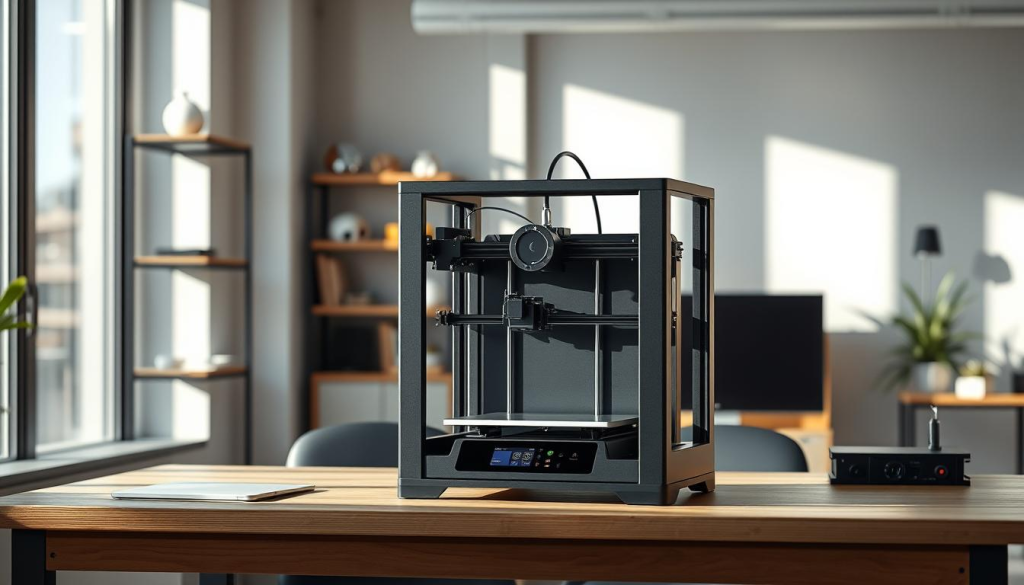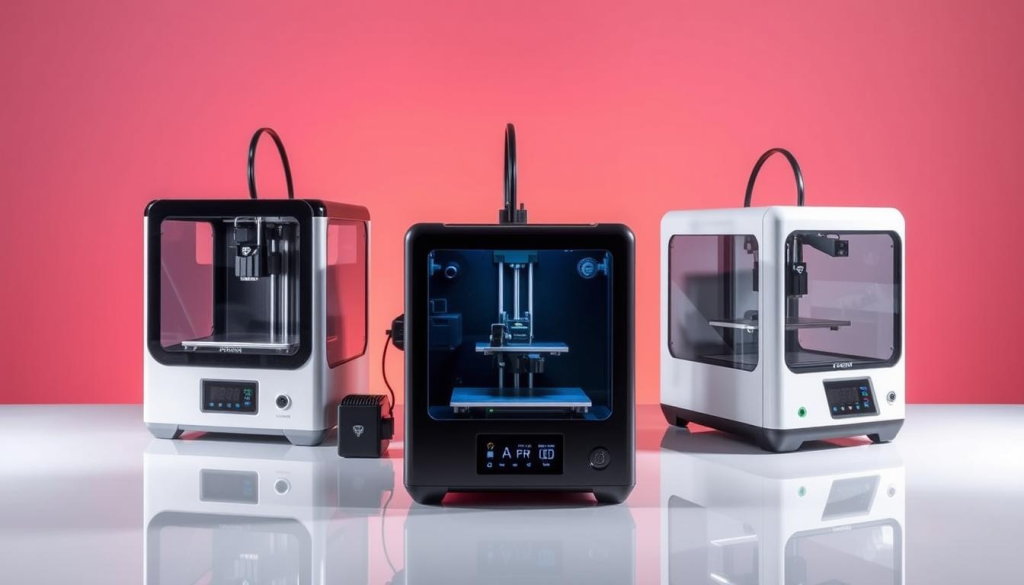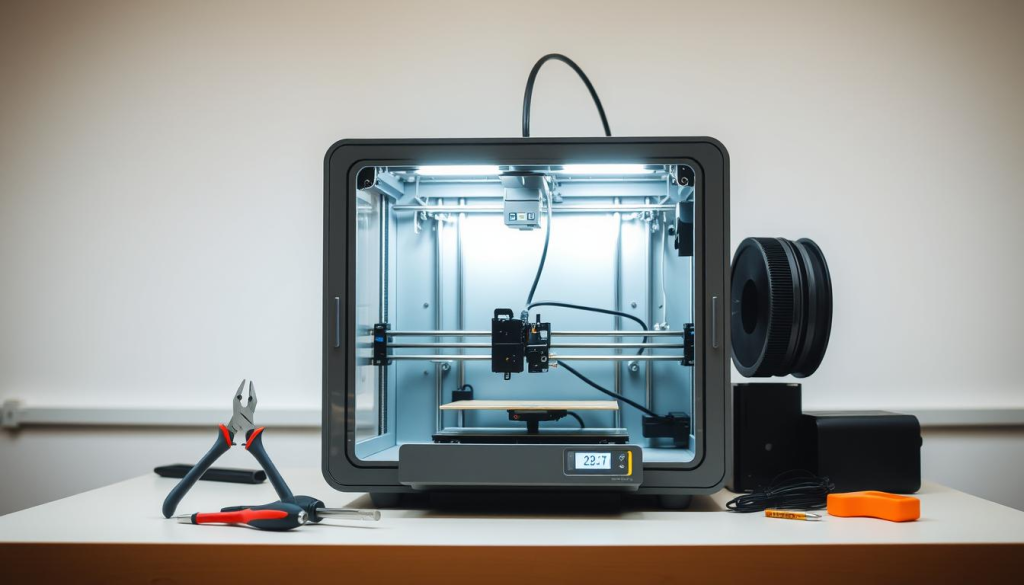3D printing has changed how we design and make things. It gives both home users and businesses new tools for creativity and efficiency. The best 3D printer lets you make things fast and customize them to your needs.
For those at home, a top 3D printer means more creative freedom. You can make unique projects that spark new ideas. In offices, these devices save money and make product development faster.
There are many models to choose from, from affordable to professional. This guide will help you find the perfect 3D printer for your space.

Key Takeaways
- 3D printing offers significant creative freedom for home users.
- Businesses can save money and work more efficiently with the right 3D printer.
- Modern printers have advanced features that improve usability and print quality.
- The best 3D printers range from budget-friendly to professional-level options.
- Rapid prototyping can speed up product development.
Understanding 3D Printing Technology
Knowing about 3D printing is key if you’re thinking about getting a 3D printer. There are two main types: Fused Deposition Modeling (FDM) and Stereolithography (SLA). FDM uses melted plastic to build objects layer by layer. It’s great for home use because it’s easy to use and not too expensive.
SLA, on the other hand, uses a resin that hardens under light. This makes it perfect for creating detailed and complex parts. It’s best for professional use where precision matters a lot. Each method has its own strengths and weaknesses, which helps you choose the right printer.
The world of 3D printing is growing fast. It’s expected to hit $41 billion by 2026, mainly because of industrial needs. Healthcare and manufacturing are big users of this technology. For example, almost all hearing aids are made using 3D printing, showing its versatility.
Here’s a table comparing FDM and SLA:
| Characteristic | FDM | SLA |
|---|---|---|
| Material Type | Thermoplastics | Liquid Resins |
| Detail Precision | Lower | Higher |
| Usage | Home applications, prototyping | Professional applications, detailed parts |
| Print Speed | Fast for basic models | Slower due to curing |
| Post-processing Needs | Minimal | Significant (cleaning and curing) |
As 3D printing gets better, it’s becoming more important in many fields. It helps save time and money while improving accuracy and customization. This is good news for industries like healthcare and manufacturing.
Benefits of Owning a 3D Printer
Getting a 3D printer offers many benefits. It helps boost creativity and makes production smoother. This tech lets you make unique designs and cuts down costs on prototypes and manufacturing.
Enhancing Creativity and Design
A 3D printer lets you create detailed models and custom items. It opens up new ways to design, making complex shapes possible. Artists and designers can quickly turn their ideas into reality, making changes in days, not weeks.
This boosts creativity and makes designing better. You can easily tweak and print new versions of your prototypes. It’s a big win for artistic expression and design improvement.
Cost Savings for Prototypes
Using a 3D printer for prototypes saves a lot of money. Old ways of making prototypes take weeks and cost a lot. But, 3D printing can do it in days, saving time and money.
It’s also cheaper than CNC machining and injection molding. With 3D printing, one person can handle everything, cutting down on costs. This not only saves money but also helps the environment by reducing waste.
Key Features to Look for in a 3D Printer
Choosing the right 3D printer is important. Look at the hardware quality for reliable prints. Also, ease of setup is key, which is great for beginners.
Print quality matters a lot. It affects how well your projects turn out. Finding a balance between speed and detail is key.
Hardware Quality and Reliability
The hardware quality of a 3D printer is very important. FDM printers work best with a heated build plate. This is essential for printing with materials like ABS.
A heated bed helps with sticking the material to the plate. It also lets you print with harder materials. Look for printers with easy-to-change nozzles and strong extruders for better performance.
Ease of Setup and Use
Setting up and using a 3D printer should be easy. Automatic bed leveling saves time and reduces hassle. It can take a few minutes to half an hour to level the bed manually.
Having filament out sensors is also great. They stop the print if the filament runs out or jams. This is very helpful during long prints.
Print Quality and Speed
Print quality and speed are important for a 3D printer’s performance. The nozzle size affects both speed and detail. A 0.4mm nozzle is a good balance.
Larger nozzles print faster but lose detail. Smaller nozzles increase detail but print slower and may jam more. Finding the right balance is key for good results.
Top Picks for the Best 3D Printers for Home Use
Choosing the right 3D printer for home use can be tough. There are many options out there. Knowing what each model can do helps you make a good choice. We’ll look at some top 3D printers for home use, focusing on speed, reliability, and cost.
Bambu Lab X1-Carbon: Speed and Versatility
The Bambu Lab X1-Carbon is known for its fast printing and versatility. It works well with many materials, making it great for different projects. Its high speed means you can get your prints faster without sacrificing quality.
Prusa MK4: Reliability and Print Quality
The Prusa MK4 is famous for its reliability and top-notch print quality. It’s perfect for both hobbyists and serious makers. It offers consistent results, making it a smart choice for those who value quality.
Creality Ender 3: Affordable and User-Friendly
If you’re looking for an affordable 3D printer, the Creality Ender 3 is a top pick. It’s easy to use, making it great for beginners. Its low price and good performance make it a favorite for new users.
Best 3D Printers for Office Use
Technology keeps getting better, and so does the need for top-notch 3D printing in offices. Precision and speed are key when picking the best 3D printers for work. Two models stand out, making them great choices for businesses looking for quality.
Ultimaker S3: Precision and Efficiency
The Ultimaker S3 is known for its amazing print accuracy and speed. It’s perfect for small projects. It has a build area of 230 x 190 x 200 mm and can print layers as thin as 20 microns.
Its user-friendly interface and strong software support make it easy to fit into your workflow. This makes it a favorite among businesses.
Formlabs Form 3: Professional Quality with Resin
The Formlabs Form 3 is a top pick for industries needing fine details, like dental and engineering. It uses SLA technology for top-notch resolution and finishes. It’s great for making detailed models and prototypes fast.
It has a build area of 145 x 145 x 185 mm and can print layers from 25 to 300 microns. This makes it a go-to for professionals.
| 3D Printer Model | Build Area (mm) | Layer Resolution (microns) | Print Technology |
|---|---|---|---|
| Ultimaker S3 | 230 x 190 x 200 | 20 to 200 | FDM |
| Formlabs Form 3 | 145 x 145 x 185 | 25 to 300 | SLA |
Comparative Analysis of Top 3D Printers
A detailed look at 3D printers shows different models with key features. These include build volume, ease of use, reliability, and how fast they print. Knowing these helps buyers choose the right printer for their needs.
3D Printer Comparison based on Features
| Printer Model | Type | Build Volume (mm) | Layer Thickness (mm) | Success Rate (%) |
|---|---|---|---|---|
| Bambu Lab X1-Carbon | FDM | 300 x 300 x 600 | 0.1 – 0.4 | N/A |
| Formlabs Form 3 | SLA | 145 x 145 x 175 | 0.2 | 98.7 |
| Creality Ender 3 | FDM | 235 x 235 x 250 | 0.1 – 0.3 | N/A |
| Fuse 1+ 30W | SLS | 165 x 165 x 320 | 0.1 – 0.4 | N/A |
Cost vs. Performance Evaluation
FDM printers start at $200 but can cost over $2,000 for professional models. Material costs also matter, with filament prices between $50 to $150 per kilogram. SLA printers are pricier but offer better surface finishes and details.
They are great for professional prototypes because of their high success rate. Choosing the best value depends on the printer’s intended use and needed features.

Where to Buy 3D Printers
Finding the right place to buy a 3D printer is key to a good experience. You can choose from online stores or local shops. Each has its own perks, fitting different needs. Knowing your options helps you make a smart choice.
Online Retailers to Consider
Many people buy 3D printers online. Sites like Amazon and 3D printing stores have lots of choices. This makes it easy to compare prices and models.
| 3D Printer | Original Price | Discounted Price | Units in Stock |
|---|---|---|---|
| Bambu Lab X1 – Carbon Combo | $1,449.99 | $1,399.99 | 7 |
| Creality Ender-3 V3 SE | $199.99 | $179.99 | 8 |
| AnyCubic Photon Mono M5s Pro | $459.99 | $299.99 | 4 |
| Elegoo Saturn 4 Ultra 12K Resin Printer | $399.99 | $399.99 | 4 |
Local Stores and Showrooms
Local stores and showrooms are great for a hands-on look. You can see printers in action and talk to experts. Brands like UltiMaker and Glowforge are often available, giving you many choices.
Knowing where to buy 3D printers makes buying easier. Each place has its own benefits, meeting the needs of many buyers.
3D Printer Reviews and Customer Feedback
Reading 3D printer reviews is very helpful for those looking to buy one. Customer feedback gives a full picture of how well a printer works, how long it lasts, and how easy it is to use. This info can help you make a better choice and be happier with your 3D printer.
Looking at what others say in reviews can help you pick the right model. It’s like getting advice from people who have already tried it out.
Insights from User Experiences
Many users stress the need for thorough testing before buying a 3D printer. They share their experiences, like how the Bambu Lab X1-Carbon prints twice as fast as the Prusa MK3S+. They also talk about the enclosed print space, which is great for printing with tough materials like ABS.
This feedback helps others find printers that fit their needs. It’s like getting tips from people who have already used the printer.
Comparing Manufacturer Support and Warranty
How well a manufacturer supports its products is very important. Reviews often say that good support makes a big difference. It helps solve problems and makes owning the printer more enjoyable.
Warranty details are also key. Some printers come with a one-year warranty, while others, like the MakerBot Replicator+, have a six-month warranty. Knowing what support and warranty options are available can make you feel more confident in your choice.
Maintenance and Care for Your 3D Printer
Keeping your 3D printer in good shape is key to its long life and quality prints. Regular care helps avoid expensive fixes and boosts print quality. This includes cleaning parts, oiling moving parts, and spotting common problems. A regular maintenance schedule can make your printing better.
Regular Cleaning and Upkeep
Keeping your printer in top shape is essential. Here are some important steps:
- Lubricate linear rods and rails every 1,000 hours.
- Dust monthly to clear out particles and fan areas.
- Check for loose parts, like drive pulleys and lead screw couplers, often.
- Clean hobbed gears after jams to remove dust.
- Remove printing waste like skirts and failed prints regularly.
Also, inspect 3D printed parts every three months for signs of deformation. Make sure to level the bed, which is critical for models without auto sensors. Do this at least once a week.
Troubleshooting Common Issues
Knowing how to fix common problems can make your printer last longer. Some common issues include:
- Clogged nozzles that stop prints and need cleaning.
- Loose belt tension causing print errors; check belt health.
- Worn Bowden tubes from retractions and extrusions; replace them for best results.
- Inspect cables often to spot wear and avoid problems.
Keeping your firmware up to date and checking the Light Processing Unit often can prevent problems. By following these steps, you save money on repairs and keep your printer running smoothly.

The Future of 3D Printing Technology
The future of 3D printing looks bright with new developments in many areas. Trends like bio-printing and new materials are changing how we make things. These changes could make old ways of making things seem outdated.
Emerging Trends in 3D Printing
New materials for 3D printing are being worked on all the time. This means we can make things that are stronger and better. Metal 3D printing is getting faster and better, thanks to new tech.
Also, 3D-printed homes might soon be cheaper than regular houses. This could help the environment by using less waste. It also lets us build things like bridges and dams in new ways.
Potential Applications in Various Industries
Many industries are excited about 3D printing. In healthcare, it could help make real organs and tissues. This could lead to better care for patients.
In dentistry, 3D printing is making dental work better. It’s also making production cheaper and closer to where things are used. This shows how 3D printing is changing business and making things faster and more custom.
Investing in an Affordable 3D Printer
When looking at affordable 3D printers, it’s key to think about budget. Buyers should compare costs and features to find the right fit. Many models offer great value without sacrificing quality or function.
Budget Considerations
Budget 3D printers usually cost between $249.00 and $399.99. This range has many options for different needs. For example, the Creality Ender-3 V3 is a top pick at $306.99. It supports six filaments, making it versatile for projects.
The AnkerMake M5C is fast and costs $399.99. It has a high print resolution of 50 microns, perfect for those who value speed. The Creality End-3 S1 Pro is great for tinkerers, priced at $306.84, down from $699.00, saving $392.16.
Best Value Models in the Market
The market has many budget models that offer great value. Here’s a comparison table of notable options:
| 3D Printer Model | Price | Best For | Print Resolution | Build Area (inches) | Weight (lbs) |
|---|---|---|---|---|---|
| Creality Ender-3 V3 | $306.99 | Overall Budget | 100 microns | 8.7 x 8.7 x 9.8 | 20.5 |
| AnkerMake M5C | $399.99 | Fast Prints | 50 microns | 8.1 x 8.1 x 9.3 | 22.0 |
| Creality Ender-3 S1 Pro | $306.84 | Tinkerers | 100 microns | 8.6 x 7.7 x 9.1 | 19.8 |
| Elegoo Neptune 4 Plus | $398.99 | Large Prints | 100 microns | 15.2 x 12.6 x 12.6 | 32.0 |
| Toybox 3D Printer | $399.00 | Children | 200 microns | 3.5 x 3.1 x 2.8 | 6.6 |
| Bambu Lab A1 Mini | $249.00 | Multi-Color | 100 microns | 4.9 x 4.9 x 5.9 | 9.0 |
Conclusion
The 3D printer market has changed a lot in the last 40 years. Today, there are many 3D printers for different needs. They help with creative projects at home and precise work in offices.
3D printing is great for quick prototypes and saving materials. It’s a key tool for innovators in many fields.
It also saves money for businesses. They can cut down on inventory costs and make their work flow better. The range of materials available makes 3D printing even more useful.
Healthcare and aerospace are just starting to use 3D printing. It’s making things more efficient, customizable, and green. Choosing the right 3D printer boosts creativity and efficiency. It also prepares users for a growing market.
FAQ
What is the best 3D printer for home use?
For home use, the Bambu Lab X1-Carbon, Prusa MK4, and Creality Ender 3 are top choices. They are fast, reliable, and easy to use.
How do FDM and SLA 3D printers differ?
FDM printers use thermoplastic materials and are great for home use. SLA printers use resin and are more precise, best for professionals.
What are the cost-saving benefits of owning a 3D printer for businesses?
A 3D printer can cut down on prototyping costs. It also helps in making quick design changes, reducing waste from traditional methods.
How important is print quality in choosing a 3D printer?
Print quality is key as it affects your project’s outcome. Finding a balance between speed and detail is important for satisfaction.
Where can I buy a 3D printer?
You can buy a 3D printer online at Amazon or in specialized stores. Local stores also let you see printers in action.
Why should I read customer reviews before buying a 3D printer?
Reading reviews gives you insights into a printer’s performance and ease of use. It helps you make a better choice based on others’ experiences.
What routine maintenance does a 3D printer require?
Keeping the print head, build plate, and parts clean is key for good performance. Troubleshooting common problems can also save time and improve results.
What are some emerging trends in 3D printing technology?
New trends include bio-printing and advancements in materials. These changes are opening up new uses in healthcare, construction, and aerospace.
How can I ensure I am investing in a value-for-money 3D printer?
Look at each printer’s features and price. Choose models that offer great performance without breaking the bank. Comparing budget options can help find good deals.
